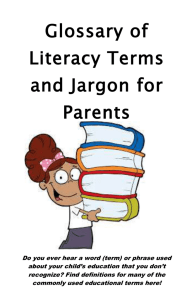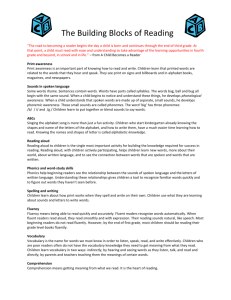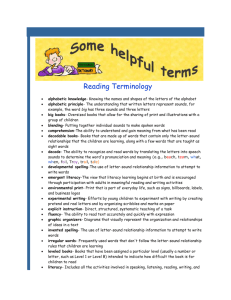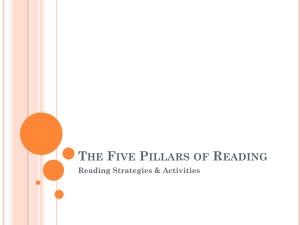2009-2010 - Middletown Public Schools
advertisement
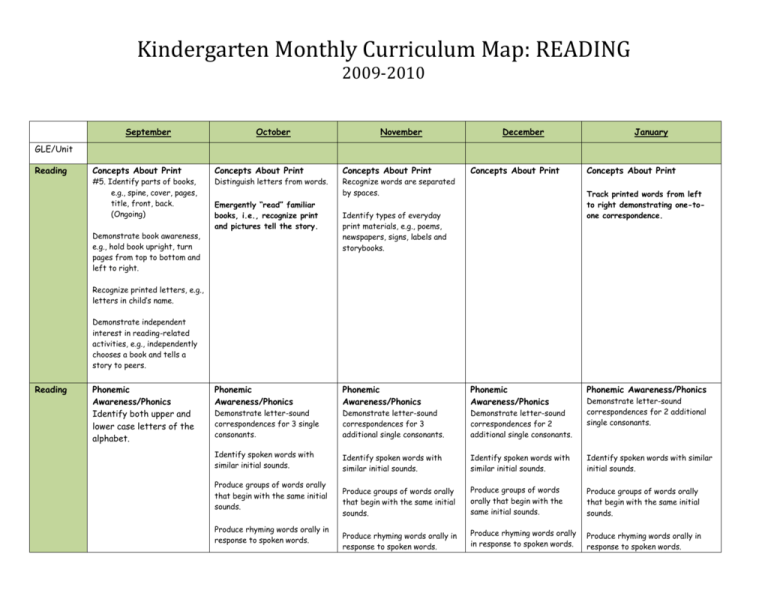
Kindergarten Monthly Curriculum Map: READING 2009-2010 September October November December January GLE/Unit Reading Concepts About Print #5. Identify parts of books, e.g., spine, cover, pages, title, front, back. (Ongoing) Demonstrate book awareness, e.g., hold book upright, turn pages from top to bottom and left to right. Concepts About Print Distinguish letters from words. Emergently “read” familiar books, i.e., recognize print and pictures tell the story. Concepts About Print Recognize words are separated by spaces. Concepts About Print Concepts About Print Track printed words from left to right demonstrating one-toone correspondence. Identify types of everyday print materials, e.g., poems, newspapers, signs, labels and storybooks. Recognize printed letters, e.g., letters in child’s name. Demonstrate independent interest in reading-related activities, e.g., independently chooses a book and tells a story to peers. Reading Phonemic Awareness/Phonics Identify both upper and lower case letters of the alphabet. Phonemic Awareness/Phonics Phonemic Awareness/Phonics Phonemic Awareness/Phonics Demonstrate letter-sound correspondences for 3 single consonants. Demonstrate letter-sound correspondences for 3 additional single consonants. Demonstrate letter-sound correspondences for 2 additional single consonants. Identify spoken words with similar initial sounds. Identify spoken words with similar initial sounds. Identify spoken words with similar initial sounds. Identify spoken words with similar initial sounds. Produce groups of words orally that begin with the same initial sounds. Produce groups of words orally that begin with the same initial sounds. Produce groups of words orally that begin with the same initial sounds. Produce rhyming words orally in response to spoken words. Produce rhyming words orally in response to spoken words. Produce rhyming words orally in response to spoken words. Produce groups of words orally that begin with the same initial sounds. Produce rhyming words orally in response to spoken words. Phonemic Awareness/Phonics Demonstrate letter-sound correspondences for 2 additional single consonants. Kindergarten Monthly Curriculum Map: READING 2009-2010 Identify spoken words with similar ending sounds. Blend up to three orally presented phonemes Segment and isolate initial, medial and final sounds of CVC (consonant-vowelconsonant) words. Blend onset and rime to form words, e.g., /d/ /o/g/ = dog. Reading High Frequency Words/ Fluency High Frequency Words/ Fluency High Frequency Words/ Fluency High Frequency Words/ Fluency High Frequency Words/ Fluency Read or sing along with correct expression and pace in books, rhymes and songs. (Ongoing.) Read at least 6 of the 34 sight words. Read at least 10 of the 34 sight words. Read at least 14 of the 34 sight words. Read at least 18 of the 34 sight words. (Ongoing through May.) Read at least 2 of the 34 sight words. (“a” and “I”) Read decodable texts to practice and gain fluency.(Through June.) Identify patterns in books, rhymes and songs. (Ongoingthrough April.) Recognize some highfrequency words taught in context.(Through June) Reading Vocabulary Identify common words in basic categories, i.e., can give examples of favorite foods or favorite colors. Vocabulary Vocabulary Vocabulary Vocabulary Kindergarten Monthly Curriculum Map: READING 2009-2010 Reading Reading Reflections/ Behaviors Reading Reflections/ Behaviors Reading Reflections/ Behaviors Reading Reflections/ Behaviors Reading Reflections/ Behaviors Before Reading Before Reading Independently “read” books for 5-10 minutes. Reading Comprehen sion Before Reading Activate prior knowledge to aid comprehension of fiction and nonfiction texts in terms of what is true and what is not true. (Ongoing.) Before Reading Before Reading Use pre-reading strategies, such as predicting and picture walks,to set context for reading and to aid comprehension.(Ongoing.) Use pre-reading strategies, such as predicting, picture walks and questioning to set context for reading and to aid comprehension.(Ongoing.) Reading Comprehen sion During Reading Make predictions about what may happen next. During Reading During Reading During Reading During Reading Identify parts of a text that seem important.(Ongoing.) Identify parts of a text that seem important.(Ongoing.) Identify parts of a text that seem important.(Ongoing.) Identify parts of a text that seem important.(Ongoing.) Create pictures from read-aloud and shared readings. Ask questions when things do not make sense.(Through June.) Reading Comprehen sion After Reading Answer literal and easy inferential questions about texts read aloud. Express opinions about texts and the reasons why, e.g., I liked …, I did not like … After Reading After Reading After Reading After Reading Identify the setting and characters in a story. (Ongoing.) Identify the topic of a nonfiction text. Identify the setting, characters, theme, conflict, and important events of the plot in a story. (Ongoing.) Identify the setting, characters and theme, in a story. (Ongoing.) Kindergarten Monthly Curriculum Map: READING 2009-2010 Oral Reading Listening Focus on the speaker when listening. Listen to acquire information and to respond to questions. Listening Listening Listening Listening Follow simple verbal two-step directions. Follow simple verbal two-step directions. Follow simple verbal threestep directions. Follow simple verbal three-step directions.(Until April-then add four-step.) Speaking Speaking Speaking Writing Conventions Writing Conventions Writing Conventions Follow simple verbal directions. Oral Reading Speaking Take turns during conversation. Share information and ideas in complete sentences. Describe objects, events, feelings, etc. with details or examples. Relate an experience or a story in a logical sequence. Speaking Participate in group discussion. Use voice level fitting of setting. Recite short poems, rhymes and songs. Describe objects, Writing Writing Conventions Write first name with correct capitalization. Use directionality of print in writing—left to right, top to bottom. Writing Conventions Kindergarten Monthly Curriculum Map: READING 2009-2010 Writing Writing Process Write name on paper. Writing Process Writing Genres, Traits, and Crafts Writing Genres, Traits, and Crafts Writing Genres, Traits, and Crafts Writing Genres, Traits, and Crafts Writing Genres, Traits, and Crafts Language Arts: Materials Writing Marzano Vocabulary : Writing Process Writing Process Writing Process Kindergarten Monthly Curriculum Map: READING 2009-2010 District Assessmen ts/CFA: February Reading: March April May June Concepts About Print Concepts About Print Concepts About Print Concepts About Print Concepts About Print Phonemic Awareness/Phonics Phonemic Awareness/Phonics Phonemic Awareness/Phonics Demonstrate letter-sound correspondences for 3 additional single consonants. Demonstrate letter-sound correspondences for 3 additional single consonants. Phonemic Awareness/Phonics Phonemic Awareness/Phonics Produce groups of words orally that begin with the same initial sounds. Produce groups of words orally that begin with the same initial sounds. Produce groups of words orally that begin with the same initial sounds. Produce groups of words orally that begin with the same initial sounds. Produce groups of words orally that begin with the same initial sounds. Produce rhyming words orally in response to spoken words. Produce rhyming words orally in response to spoken words. Produce rhyming words orally in response to spoken words. Produce rhyming words orally in response to spoken words. Produce rhyming words orally in response to spoken words. Identify spoken words with similar ending sounds. Identify spoken words with similar ending sounds. Identify spoken words with similar ending sounds. Identify spoken words with similar ending sounds. Identify spoken words with similar ending sounds. Blend up to three orally presented phonemes Blend up to three orally presented phonemes Blend up to three orally presented phonemes Blend up to three orally presented phonemes Blend up to three orally presented phonemes Segment and isolate initial, medial and final sounds of Segment and isolate initial, medial and final sounds of Segment and isolate initial, medial and final sounds of Segment and isolate initial, medial and final sounds of Segment and isolate initial, medial and final sounds of Demonstrate letter-sound correspondences for 2 additional single consonants. Demonstrate letter-sound correspondences for 2 additional single consonants. Demonstrate letter-sound correspondences for 2 additional single consonants. Kindergarten Monthly Curriculum Map: READING 2009-2010 CVC (consonant-vowelconsonant) words. CVC (consonant-vowelconsonant) words. CVC (consonant-vowelconsonant) words. CVC (consonant-vowelconsonant) words. CVC (consonant-vowelconsonant) words. Before Reading Confirm meanings of unknown words, using prior knowledge, context, photos, illustrations and diagrams. (Through June.) Identify the number of syllables in three-syllable words. Identify the number of syllables in three-syllable words. Identify the number of syllables in three-syllable words. Identify letters matched to short vowel sounds. Substitute initial phoneme sounds. Substitute initial phoneme sounds Use common consonant sounds with short vowels to decode three letter words. Identify letters matched to short vowel sounds. Identify letters matched to short vowel sounds. Use common consonant sounds with short vowels to decode three letter words. Use common consonant sounds with short vowels to decode three letter words. During Reading Make connections between text and self.(Through June,) After Reading Make text-to-self connections.(Ongoing.) After Reading Retell information from a story, using proper sequence.(Ongoing.) Reading Reflections/Behaviors Choose a book to read, and share it with the teacher and classmates. Language Arts: Marzano Vocabulary: District Assessments: Reading Reflections/Behaviors Choose a book to read, and share it with the teacher and classmates.





